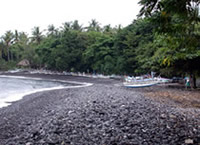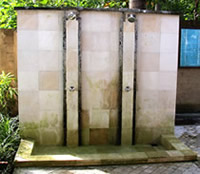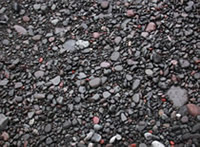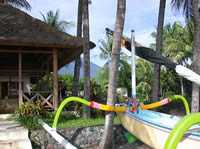![]()
![]()
![]()
Tulamben & Seraya
Diving in Bali - What You Will See

Tulamben is a little village on the eastern side of Bali, about a 3-hour drive from Sanur. Tulamben is famous among divers all over the world. If you go diving in Bali and haven't dived at Tulamben before, you must spend at least a day here as a rite of passage.
Divers first started diving there in 1979 to visit Tulamben Bay's Liberty wreck, which can be reached just 40 metres from the shoreline and is barely 10 metres deep at its shallowest end. Today, other than the wreck, there are plenty of other dive sites in the general Tulamben area to explore. There are a handful of dive resorts to stay in, and these are handy if you're going to make Tulamben Bay your base while you explore nearby dive sites like Batu Kelebit and Seraya. (Details on where to stay are in Part 2).
Different people will have different ideas on what is the most unique thing about Tulamben. For me, it was the sound of the round grey pebbles clattering against each other as the waves retreated from the shore. Imagine a million mahjong tiles being pushed against each other at frequent and regular intervals - that's how loud it was.
Seraya the dive site is not to be confused with Seraya the land-locked town, which is quite a distance from the seaside. To get there, we took a 10-minute drive from Tulamben Bay, to Scuba Seraya Resort.
The Scuba Seraya Resort is a very pleasant beachfront resort with a friendly dog with a healed broken leg and a bandana found its neck, great food, spacious dive facilities, clean toilets and an excellent soap dispenser.
Many of Tulamben Bay's dive sites, including The Liberty Wreck, are accessible by shore dives. Shore dives at Tulamben aren't the usual shore dives you might be used to.
1. You will set up your dive equipment and put on your wetsuit and booties at the resort. But don't put on your BCD tank. There is a local cooperative of porters (females and young boys) who will carry your equipment on their head. This is already part of the dive cost.
2. You will then carry your fins in your hand, and walk to your entry point on the shoreline. If you're like me and don't have a very good sense of balance, this isn't very easy. You'll want to be careful not to twist your ankle on the pebble beach. The walk takes about 5-7 minutes. This can be tough if you're carrying a heavy camera with two strobes. DON'T RUSH.
3. At the entry point, your wetsuit will feel like a sauna and you will want to run straight into the water to cool down. But the right thing to do would be to put on all your equipment except your fins. Then, walk carefully into the water. I lost balance countless times and fell but didn't get hurt. At this point, the guide and little boy porters were real gems. They held my hand all the way into the water, until they saw that I was ok. (Chivalry meter: EXCELLENT) When the water reaches about mid-thigh, face the shore, recline on your back, use your feet to push off, THEN put on your fins. Then fin out a little more before descending below the water surface.
4. When you complete your dive, remove your fins while you're still in the water (it helps when your feet can touch the bottom). Then walk up the shore slowly (like me, you might lose balance and fall a million times but just lean forward as this will enable you to fall slowly without hurting yourself or your tank). When you are out of reach of the waves, take off your BCD and tank. If the guide or porters aren't free to help you, my advice is to perch your bottom (and hence your tank) on one of the higher tide-created terraces of pebbles, then take off your BCD.
5. The porters will carry back the tank and BCD, while you walk back with your fins and mask.
Note: don't try walking on the shore barefoot. It can be painful.

The signature black pebbles of Tulamben Beach 
Seraya

Friendly Scuba Seraya dog

Scuba Seraya shower

Scuba Seraya Dunk Tanks

This is what you walk on on your way to your shore dive
In a Nutshell
When entering the water, hold the porter's hand.
When in the water, push off with your feet before putting on your fins.
When exiting the water, lean forward to counter-balance from falling backwards.

Uh oh, no ladders on the boat!
How to get into boats with no ladders
For Tulamben dive sites that are too far for a shore dive, you will take a jukung. A jukung is like a very deep canoe, with outriggers on both sides. Maximum capacity 3 persons (two seated passengers and the guy who steers the boat and mans the engine). The reason why I devote a whole section to this is because:
the jukung does not have a ladder.
But do not fear, zis is divewithsus.com. I am 'ere to 'elp you, so do not 'esitate to call on me. Read on for how to get in and out of a boat without ladders. Bookmark this page!!!
1. Before you start, set up your equipment and don your wetsuit and booties at the resort. The porters will carry your BCD and tank to the jukung, while you just walk there carrying your fins. When you reach the jukung, point out your gear and in it goes into the jukung.
2. Then you help to push off the jukung by holding onto its outriggers. I must point out here that if you look like a helpless female, chances are, the men will signal to you to just get in first :-). The seat is basically a bamboo sort of mat placed across the width of the jukung. Place your fins at your feet for easy retrieval later. Sit facing the shore because when the jukung is afloat, they'll turn it 180 degrees to steer.
3. When you reach the dive site, the jukung-man will tell you to put on your fins while you're seated. After doing this, slip into the water. You can do this easily because the outriggers will prevent the boat from capsizing or rocking violently.
4. Once you're in the water, the jukung-man will pass you your equipment. Remember you learnt to do this for Open Water? So put it on, wait for everyone else to finish putting theirs on, and off you go for your dive.
5. After your dive, unclip your BCD (and weight belt if you're wearing one) when still in the water and hand it to the jukung-man who will put it onto the jukung. Now comes the tricky part - getting into the jukung. Holding onto the edge of the jukung in an upright position, fin as if your life depended on it. Fin the water under you until the water lifts you naturally. When the water lifts you to a height you're comfortable with, heave yourself onto the boat using a combination of natural bouyancy and arm strength. I tried doing this but as it was my first time, the guide had to push me up from the water, and my buddy had to pull me up from the boat. But with practice I know this can be done without assistance because I met a petite lady who told me how to do it, and if she can do it, so can all of us. She learnt it the hard way in Thailand, where the dive operator forced her to do it without assistance until she got it right. (That rules out Thailand for me, till I learn the art of getting onto a boat this way).
Another way to get on is to submerge yourself completely and then give a few powerful strokes of your fins. Then grab the edge of the boat and climb on.
6. When you're back in the jukung, hopefully with your dignity still intact, take off your fins and enjoy the cruise back. When you arrive on shore, get off the jukung and help pull it up. Or at least pretend to while the guys do the real work. The porters will carry back your BCD and tank, and you walk back carrying your fins.
Climbing Into This Without a Ladder

When I first saw these, I went into denial

In a Nutshell
1. Hold the edge of the boat, then fin madly to achieve bouyancy
2. Don't be the last person to climb into the jukung. You might need him/her to help to push you up and into the boat. (For me, I'd rather my buddy push my butt than have the whole world looking at me pityingly as I try to get into the boat without help.)
